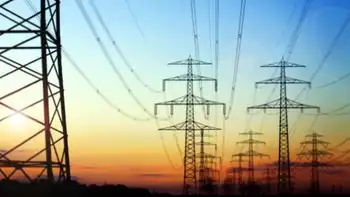Clean energy technology pitched as savior of U.S. economy
By United Press International
NFPA 70e Training - Arc Flash
Our customized live online or in‑person group training can be delivered to your staff at your location.

- Live Online
- 6 hours Instructor-led
- Group Training Available
A number of policymakers hope to green the nation's energy supply and create new jobs through measures in the next stimulus legislation, expected to be one of the top priorities for President-elect Barack Obama and the next Congress.
"By investing in green technology, we can create the jobs we need today to be competitive in the future," Sen. Benjamin Cardin, D-Md., said at a briefing in the Senate Environment and Public Works Committee.
International competitiveness in the energy sector is essential for economic recovery because the market is so big, said John Doerr, a partner at Kleiner Perkins Caufield & Byers, one of the top venture capital firms for clean energy technology.
"Going green may be the largest economic opportunity of the 21st century," he said. "It is the mother of all markets."
Doerr told senators the United States doesn't currently lead the international marketplace producing and selling clean energy technology, citing a number of emerging renewable energy technologies his firm is financing.
"Notice the trend here," he said. "If you list today's top 30 companies in solar, wind and advanced batteries, American companies hold only six spots. That should be a warning to us all."
Doerr outlined a number of recommendations for the stimulus package and future legislation: Create a new national electricity grid to get more electricity from renewable sources to consumers; mandate that a certain percentage of electricity nationwide come from renewable sources; give utility companies incentives to increase efficiency; spend more money on research, development and deployment of green technologies; create a scholarship fund for students studying engineering; and place a price on carbon, either through a tax or a cap-and-trade scheme.
Debate currently rages over whether short-term attempts to boost green jobs can revitalize the economy without a nationwide price on carbon. Proponents say such price incentives are necessary to spark investment, while opponents argue federal tinkering with the market will write the economy's obituary.
Congress has debated, and ultimately rejected, a number of cap-and-trade bills. If one does pass, it would cap total U.S. carbon emissions at a certain level and allot emissions shares to businesses and other entities, which could then sell their shares if they cut their emissions below the mandated level.
Significant opposition to a cap-and-trade program continues in the new Congress, and Republicans are not likely to support similar legislation this year, including Sen. James Inhofe, R-Okla., ranking member of the Environment and Public Works Committee.
"The cap-and-trade or carbon tax approaches are misguided," said Marc Morano, the committee's GOP spokesman. "Inhofe does not believe the way to create jobs is by killing more jobs," he said, adding that is what "would happen if the Senate passed such legislation."
Proponents counter that without a price on carbon, small-scale attempts to green the energy sector and increase jobs in renewable energy will be equally small in their effect on the economy. That's because cheap, dirty technologies already exist, so the market won't provide opportunities for large-scale deployment of clean alternatives without a price incentive imposed by the government, said Thomas Friedman, author of the recent best-seller "Hot, Flat, and Crowded: Why We Need a Green Revolution — And How It Can Renew America."
"Launching the green revolution without a price signal would be like trying to launch the Apollo space program if Southwest Airlines already flew to the moon," he said.
Opponents say a cap-and-trade program or other efforts to spur job growth through clean energy mandates would seriously damage the economy, outweighing any possible benefits. Even if such efforts create more green jobs, they're likely to have a negative effect on total employment numbers, said David Kreutzer, senior policy analyst in energy economics at The Heritage Foundation, a right-leaning think tank.
"When you divert $15 billion per year from some other part of the economy, you destroy jobs in that sector," Kreutzer told United Press International. "If you just look at the benefits, instead of the costs, anything looks good."
A cap-and-trade system or other mandates for renewable energy ultimately would raise energy costs, Kreutzer said, which is the exact opposite of what the government should do to address the nation's financial problems.
"One of the big contributors to the current economic crisis was the spike in energy costs over the past year," Kreutzer told UPI. "You want to keep energy costs low by adding to our energy supply, through (domestic) oil drilling, and not adding new regulations to industry that force them to use more costly forms of energy."
One of the big concerns about a cap-and-trade system is its potential to stymie the competitiveness of U.S. companies, particularly if China and India don't pass similar laws. But its proponents say a cap-and-trade program would spur innovation, allowing the United States to outpace foreign competitors.
"I say to China, 'If you want to give America a five-year lead, God bless you.Â… Grow as dirty as you want, because we are going to clean your clock,'" Friedman told senators.
It may not be that easy to monopolize the clean energy arena, though, particularly as China already is making significant advances in this area, said Jennifer Turner, director of the China Environment Forum at the Woodrow Wilson Center, a non-partisan research institution.
"China has actually done a lot in terms of energy efficiency," she said. For instance, "China is the largest producer and consumer of solar water heaters."
China, whose energy demands are huge and ever-increasing, certainly isn't waiting for the United States to take action, Turner told UPI.
"I think the Chinese have already said, 'We can't wait for these guys,'" Turner said. "So they're working with the Europeans and the Japanese right now."
"Creating a marketplace for clean energy technologies sends a signal to companies, and that encourages the development of these technologies, which, hopefully, you can export in the future," Will Pearson, global energy and natural resources analyst at the Eurasia Group, a global consulting firm, told UPI.
Because it's a long-term plan, though, Pearson said he projects cap-and-trade legislation will be delayed, while short-term fixes are implemented in the stimulus package.
"The main goal of the stimulus is to get people working," he said.
As a result, Pearson expects to see funding going into immediate job creation, including weatherization projects, increased funding for clean energy research and financing to build green technology infrastructure.











